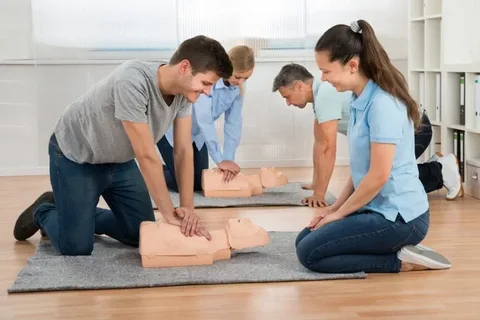Today’s students are more than just learners—they’re leaders, helpers, and changemakers. As they prepare for adulthood, career paths, and life beyond the classroom, one essential skill often gets overlooked: first aid.
But here’s the truth—knowing how to respond in an emergency doesn’t just save lives. It builds confidence, responsibility, and awareness. That’s why understanding why first aid certification is important for students is a conversation worth having in every school, household, and youth program.
In this post, we’ll break down the real-world reasons students should be certified—and how it shapes them for success beyond academics.
Why Teach First Aid to Students?
Emergencies can happen anywhere: during gym class, on a field trip, at a part-time job, or even at home. Teaching students how to respond can mean the difference between panic and poise, injury and recovery, or even life and death.
First aid certification gives students:
- 💪 Life-saving skills
- 📘 Practical education outside textbooks
- 🧠 Greater awareness and emotional intelligence
- 🗣️ The confidence to take action
- 🌍 A way to positively impact their community
Want a deeper dive into this topic? This excellent resource outlines why first aid certification is important for students and offers five compelling reasons to make it a priority.
What Students Learn Through First Aid Certification
Getting certified isn’t just about memorizing procedures—it’s about learning how to think clearly and act effectively when every second matters.
A typical student-friendly first aid course covers:
- Treating cuts, burns, or sprains
- Performing CPR and using an AED
- Handling choking incidents
- Responding to allergic reactions or asthma attacks
- Staying calm under pressure and alerting emergency services
These skills translate to every environment a student might be in—school, sports, work, or public spaces.
Top Reasons Why First Aid Certification Is Important for Students
Let’s take a closer look at why these skills matter—starting now, not later.
✅ 1. Emergencies Can Happen Anywhere
Whether it’s a scraped knee on the soccer field or a classmate choking in the lunchroom, emergencies don’t wait for adults to show up. Certified students can provide immediate care until help arrives—making them a true first line of response.
✅ 2. It Builds Confidence and Responsibility
When students know how to respond in high-pressure situations, they gain more than first aid knowledge. They gain confidence, critical thinking skills, and a deeper sense of personal responsibility.
These traits carry over into academics, leadership roles, and future careers.
✅ 3. It’s a Competitive Advantage for College and Jobs
Many employers and universities value first aid certification. It shows initiative, maturity, and readiness for real-life challenges—especially in fields like healthcare, education, public safety, and recreation.
✅ 4. Promotes a Culture of Safety and Compassion
When one student learns first aid, it influences others. Certified students are more likely to help classmates, support school safety efforts, and encourage friends to get involved too.
This creates a ripple effect—leading to a more caring, aware, and prepared student body.
✅ 5. Lifelong Skills That Stick
Unlike some classroom topics, first aid is a life skill that never goes out of style. Students carry this knowledge into adulthood, where it may benefit their families, workplaces, and communities for years to come.
How Schools and Parents Can Support First Aid Education
- Incorporate training into health or PE classes
- Host school-wide certification days
- Encourage clubs or volunteer programs to offer courses
- Talk about emergencies at home and practice responses
Affordable, online programs like those from SimpleCPR make it easier than ever to offer accessible, flexible training for students of all ages.
Final Thoughts: First Aid Is More Than a Skill—It’s a Superpower
Knowing why first aid certification is important for students is the first step to empowering them. These aren’t just lessons for the classroom—they’re tools for life.
As future leaders, students deserve to feel prepared, not powerless, when something goes wrong. And sometimes, a single certified student can make all the difference.





